11 Types of Landscaping Rocks to Improve Your Property
Author: Rick Worst | Editor: Omar Alonso
Review & Research: Jen Worst & Chris Miller

The rocks that are used for beautifying lands are broadly categorized as types of landscaping rocks. Depending on the theme of the project, such as flora or fauna, terrain, water, weather, etc., different types of rocks for landscaping are used.
Landscaping, that is, modifying the aesthetic features of a particular area, is a tasteful and elegant way of beautifying the surroundings of a residential area or workplace. It demands a combination of artistic insights and horticultural know-how. This art form often sees the use of rocks as a primary motif.
11 Types of Landscaping Rocks
To pinpoint the exact type of rock that’s needed for a particular landscaping endeavor, it’s necessary to get a good grasp of the size, shape, color, formation process, and chemical properties of different landscaping rocks. The list below brings exactly that info to the table.
Decomposed Granite
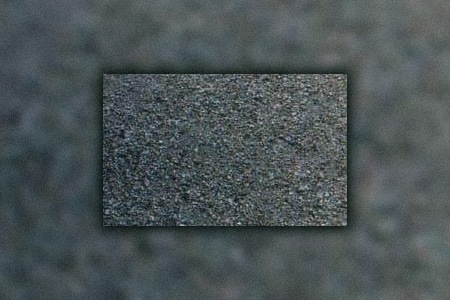
Decomposed granite is one of the most common landscaping rocks. It’s been in use ever since landscaping has become a phenomenon. Though it has a lot in common with gravel, it’s sandy and much finer than gravel.
Primarily of a grayish color, it may also have a dark brown to light red texture. It is formed by many years of geological events such as erosion and weathering.
Available in three distinct forms of landscaping rock types, decomposed granite can be stabilized, natural, and stabilized. In its natural form, also known as loose decomposed granite, the small granite particles aren’t mixed with some other material. Thus they’re ‘loose’ and susceptible to erosion caused by water runoff.
The other two types of decomposed granite aren’t found in nature. Rather, they are modified by mixing other ingredients into the granite aggregate. The stabilized form is a combination of natural decomposed granite and stabilizing agent.
This makes it much less prone to erosive forces. In comparison, the resin-coated variant has resin mixed into the aggregate. Thus it’s almost immune to erosion and can last for ages.
Crushed Granite Gravel
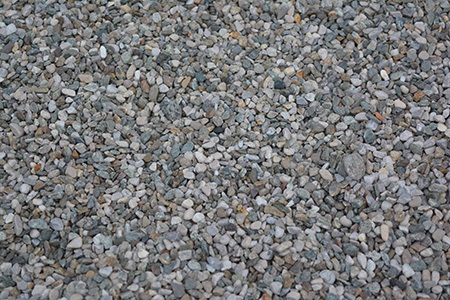
Crushed granite gravel features much larger grains than its decomposed counterpart. Because of the bigger size of grains, it cannot hold water in its relatively larger intermediary spaces. This allows thorough drainage and prevents water erosion. Thus it requires little to no maintenance.
Unless subjected to heavy and regular dynamic load, crushed granite gravels can last for ages without any wearing. It’s widely available and for the same tonnage, can cover a much larger area than most other landscaping rocks. As explained earlier, it doesn't hold much water for long.
Thus it’s particularly suitable for the prevention of puddling. From earthly brown to tan to light gray, it’s perfect for natural blending without much color contrast.
Much of the advantages the crushed granite gravel has over other landscape materials comes from its larger particle size.
These types of landscaping rocks also have a negative side to it: bigger inter-particle spaces make it prone to further crushing if subjected to heavy regular loads. That said, it doesn’t take a lot of expertise to install or maintain it.
Pea Gravel
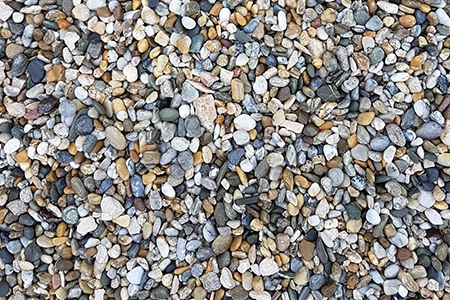
The name Pea gravel comes from the peas size grains of these landscaping rocks. To be exact, the grain radius is between ¼ to ⅛-inch. The gravels have a very smooth surface; this is because of their long exposure to a fast-moving current of water.
This is the primary reason why these pebbles can be found close to constantly moving bodies of water like streams. Transport them from there (or the nursery store) to your home and they can make great walkways or patio surface alternatives.
Available in several colors and shades, most of the Pea gravels are of earthly tones. Because of its well-rounded shape, the gravel rarely goes through frictional erosion.
The small size also ensures better protection against both constant and dynamic loadings. All these properties make it highly resistant to wear.
But their small size is both a blessing and a curse. They get easily displaced by walking, driving, and even strong winds. Thus they need regular raking.
And these can also give people an uncomfortable experience by getting into shoes and clothing. The small size also causes it to be a choking hazard, primarily for children.
River Rock
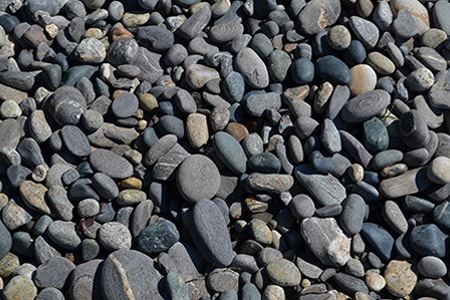
Just like pea gravels are formed in rushing streams with fast currents, river rocks are shaped in reverse with a comparatively low-speed flow of water. The constant flow smoothens the surfaces of the rocks.
But unlike pea gravels, these rocks can be of bigger sizes, from small to medium to very big ones. The large stones can be used as accent rocks in dry creeks and ponds.
Whereas, the small stones are used as stone mulch and filler material between stepping stones. Because of the smooth surface and relatively large size of these types of landscaping stone, they don’t impede the drainage of water.
River rocks come in various colors. Though the predominant tone of these stones is a mixture of gray and earthly brown.
For their ability to add a stunning beauty without hindering the natural feel of the landscape, these rocks have been extremely popular ever since the idea of landscaping has come into existence.
Lava Rock
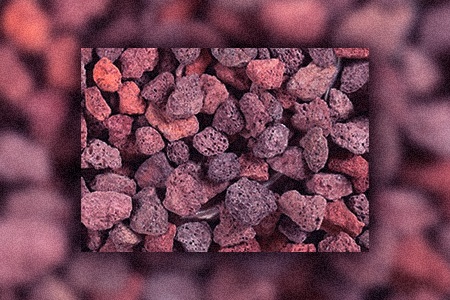
When volcanic eruptions take place, huge amounts of extremely hot earthly material, or lava, come out. These molten materials, once cooled, form dark reddish rocks, sometimes called foamed obsidian. Such rocks are generally brittle and get broken into small pieces and the resulting stones are called lava rocks.
These types of landscaping rocks have an explosive bold color that makes them suitable for the beautification of almost any landscape. Lava rocks are quite fragile and get further broken into smaller particles.
This finer grain gets mixed with soil and makes the land more fertile. Being lightweight, they’re very easily transportable. Lava rocks can absorb a lot of heat during the day and release it at night. This makes it particularly suitable for drier climates.
They can also absorb water and moisture. During rain, they retain water that gets distributed to the plants later on. Like most materials formed by deep-earth geology, like coals, for example, they’ve got antiseptic properties. They also prevent bugs and weeds.
Brick Chips
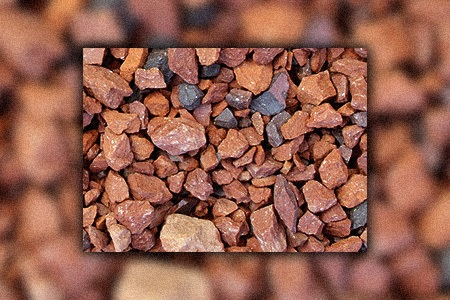
Despite not being natural rocks, not rock at all, brick chips are often used for landscaping purposes. Primarily it’s used as a paving material. Its popularity stems from the high availability and the resulting low cost.
The heavy, used construction materials like bricks are rather expensive and difficult to get rid of. So they’re sold at knock-down prices compared to other types of landscape rocks.
Brick chips come in a variety of colors. This makes it suitable for people who are very particular about the color of the rocks but can’t find stones of that tone. Though most people are familiar with reddish and brown bricks, they can also be black and yellow.
With all these advantages, brick chips have some serious drawbacks as well. They can have extremely sharp edges. So paths covered with brick chips are not suitable for a bare-foot walk. That's the problem with these, the most different rocks for landscaping. They're only for looks.
This can also cause issues for pets. Just like it’s bought cheap, it can barely be sold. And removing the chips for replacing them with new landscaping materials is also very costly.
Marble Chips
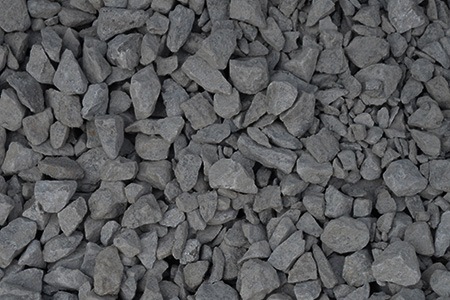
Slabs of marble are used for tabletops, kitchen and bathroom countertops, as well as expensive internal decorations. But in chip forms, it can be used for landscaping.
The sleek and classy look of marble makes it suitable for decorating gardens. It makes an expensive but stunning alternative for crushed gravel.
Due to the wide range of colors, it can fulfill a variety of aesthetic demands. Its reflective nature also accentuates the beauty of the locations it’s decorated with. Marble chips are particularly suitable for small-scale projects such as container gardens.
Because of its high reflectivity of both heat and light, marble mulch types of landscaping rocks can become hazardous for some plants. This issue can be even more pressing in hot climates. Being an alkaline stone causes a change in the pH level of the soil and thus impedes the growth of plants that need acidity.
Flagstone
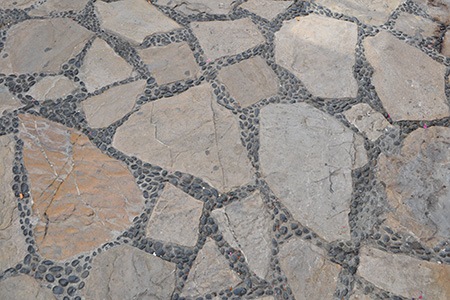
Flagstones are sedimentary rocks formed by natural mixed cementation between feldspar and quartz. Because of the nature of the formation process, they are flat and usually of almost constant thickness.
This makes them an obvious choice for projects where the creation of a flat, hard surface is needed. For example, types of driveways, garden paths, and types of patios are all perfect for using flagstone as the surface.
In landscaping projects, where sandstone, slate, travertine, bluestone, or limestone are needed, but they’re either unavailable or too expensive, flagstone can be a perfect replacement. It’s also a great alternative for concrete pavers. People prefer these types of pavers over more basic ones due to them appearing much more natural.
The stunning look of these types of landscaping stones is coupled with a relatively high price tag. Because of the difference between the thickness of a number of flagstones that are to be pieced together, installation of flagstones can be time-consuming and challenging. Hiring a professional landscaper or stonemason is also pricey.
Boulders
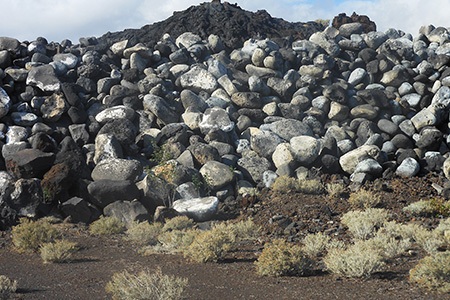
Boulders, whether real or artificially casted, can look amazing with your landscaping. You can have them sourced from a location you desire, purchase pre-found ones and have them shipped to you, or even excavate them on your own unimproved land you bought for development.
If they're of a sufficient size they'll require heavy machinery to put in place. Whether placed in a bed of flowers, in the lawn as a place to sit, at the base of trees, or anywhere else, this can make an area feel older and more powerful than it really is.
Beach Pebbles
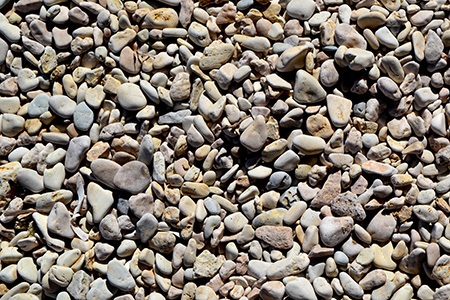
Beach pebbles aren't too different from river rocks in concept or usage, but the difference is that they tend to be smaller. You'll have a much higher quantity of them to cover the same amount of space.
Because they're smaller they're less likely to cause issues when used in walkway paths. These types of landscaping rocks are an easy way to maintain garden beds too, as you can lay them on top of plastic and then play for weeds without damaging the other plants and shrubs.
Retaining Wall Stones
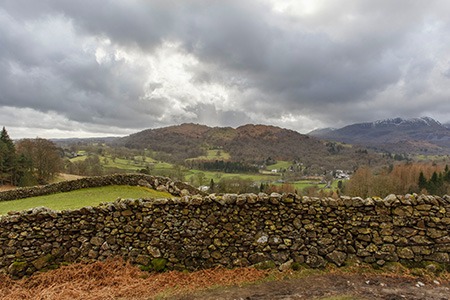
Retaining wall rocks are large rocks, but not quite the size as the boulders we mentioned above. You can incorporate these as borders for flower beds, as fences with benches on top, or even as natural stone walkways. Just get creative and you'll find plenty of ways to use them.
You can also check out our list of retaining wall alternatives that may give you further ideas on how to use these large stones or other variations on them.
Types of Landscaping Rocks for the Perfect Layout
Deciding whether the rock or the combination of rocks is suitable for a particular land, one should know and think thoroughly about both the rocks and the theme. Only this, coupled with dedicated care, can create a truly enchanting landscape.
From paving the path in one's garden to covering the flowerbed with pretty-looking mulch to creating an artificial stream that can rival the fairytales, for different projects, different types of landscaping rocks are used.



